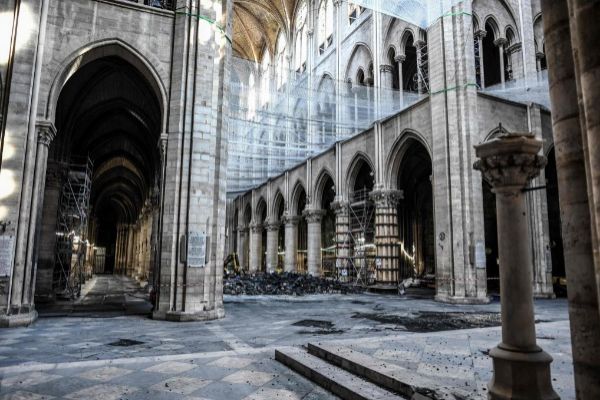- Architecture: The heat wave could cause new landslides in the dome of Notre Dame
- Chronicle: First mass in Notre Dame after the fire
- Notre Dame.The staff took 30 minutes to call the fire department
- Investigation: The Prosecutor's Office dismisses the criminal origin of the Notre Dame fire and investigates whether there was negligence
The works of the Notre Dame de Paris cathedral resumed on Monday with reinforced security measures, after they were paralyzed for three weeks due to the risks of over-exposure of lead workers. The safety protocol has been reinforced for the workers who work in the consolidation and debris removal works of the cathedral, which suffered a spectacular fire on April 15.
The flames devoured the wooden structure of the ceiling of the cathedral, the spire that crowned the building collapsed and part of the vault was destroyed in the fire. But the walls of Notre Dame remained standing. They managed to save the rosettes and numerous treasures , relics and artistic works that were inside.
Four months after the fire, Notre Dame is still not safe. Patrick Chauvet, rector of Notre Dame de Paris, was "relieved" on Monday that the works of Notre Dame have resumed, as the race against the clock to save the building continues. There is still a risk that part of the building will collapse and those responsible believe that the sooner the works resume, the better.
The work of consolidation and removal of debris will continue in the coming months. It has not been completed to reinforce the arches of the cathedral or to remove the burned remains of the wooden roof that burned during the fire and is still under the vault. "It takes at least four months to remove all that ... We can say that the cathedral will be saved in early 2020 ," Chauvet said in statements to the France Info chain.
The Ministry of Culture still sees a risk of collapse of the cathedral. Before the restoration of the cathedral begins, the building must be perfectly consolidated. This summer there were new rockfalls from the vaults of the ship as a result of the two heat waves suffered by the French capital.
The most difficult and delicate operation will be when you have to disassemble the steel scaffolding that had been erected, before the fire, to restore the arrow of the cathedral that crowned the building and was built in the nineteenth century. The fire welded the scaffolding so they cannot be disassembled. To remove them you have to cut them. To do this, they must first install an iron above the cathedral to protect the parts that are still standing. Many fear that when the scaffolding is removed, parts of the building will collapse like a house of cards .
The prefecture of Paris suspended the works of Notre Dame on July 25 for a few days to review the protocols for the protection of workers against lead. Decontamination work in the immediate vicinity of the cathedral has also been carried out in recent days. The fire melted about 400 tons of lead from the cathedral and released large amounts of toxic particles that settled in the surrounding streets and buildings.
Parisians are worried about the consequences that high levels of lead in neighborhoods around the cathedral could have on their health. Blood tests have been carried out on the inhabitants of the area and the workers who work in Notre Dame to detect if they suffer from saturnism or lead poisoning.
French President Emmanuel Macron set the ambitious goal of restoring Notre Dame in five years, just in time for the 2024 Paris Olympics .
After the fire of Notre Dame, there was a wave of promises of donations. Four months after the incident, only 12 percent of the 850 million euros promised has reached four of the main organizations responsible for raising funds for restoration, according to data published by the French press.
According to the criteria of The Trust Project
Know more- culture
- Notre Dame
- Architecture
The unleashed look Alberto Campo Baeza: "How to make people see that most of the time their houses are a horror"
Culture Norman Foster will wear a 'txapela' at the Bilbao Fine Arts Museum
País VascoFoster, a 'txapela' for the Bilbao Fine Arts Museum

